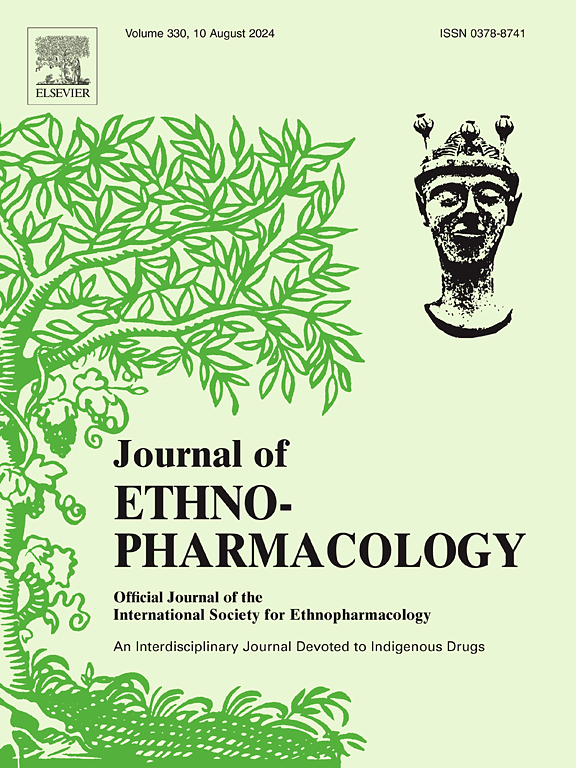Ethnomedicine, phytochemistry, pharmacology, pharmacokinetics, and clinical application of Salvia miltiorrhiza Bunge (Lamiaceae): A comprehensive review
IF 4.8
2区 医学
Q1 CHEMISTRY, MEDICINAL
引用次数: 0
Abstract
Ethnopharmacological relevance
Salvia miltiorrhiza Bunge (Lamiaceae), known as Danshen in China, is a widely utilized traditional Chinese medicine (TCM). Danshen is classified within the heart and liver meridians and renowned for its ability to activate collaterals and blood vessels, facilitate the removal of blood stasis without compromising vital Qi. It plays a pivotal role in promoting blood circulation and alleviating blood stasis. Clinically, it is commonly used to treat uterine bleeding, irregular menstruation, blood stasis, and abdominal pain, among other symptoms.
Aim of the study
This paper reviews the traditional use, botany, phytochemistry, pharmacology, toxicity, pharmacokinetics and clinical application of Danshen from 1981 to 2024. The goal is to offer valuable reference materials that can inform and guide future research related to Danshen.
Materials and methods
A literature search was performed on Danshen based on classic books about Chinese herbal medicine and different electronic databases including Web of Science, PubMed, Elsevier, ScienceDirect, Google Scholar, SciFinder, TPL, and CNKI.
Results
Traditional uses of Danshen have been documented in China for centuries. A large number of studies have shown that Danshen is rich in chemical components. To date, more than 318 chemical compounds have been isolated and identified, including diterpenoid quinones, phenolic acids, triterpenes, essential oils, neolignans, alkaloids, flavonoids, saccharides, and others. Crude extracts and pure compounds isolated from Danshen exhibit a wide range of pharmacological effects, including anti-atherosclerotic, anti-arrhythmic, anti-thrombotic, anti-hypertensive, anti-myocardial ischemia-reperfusion injury, endothelial dysfunction protection, sedative and analgesic, neuroprotective, anti-depressive, anti-hepatic fibrosis, anti-pulmonary fibrosis, anti-renal fibrosis, anti-inflammatory, anti-oxidative, anti-tumor, anti-diabetic effects. The results of pharmacokinetic studies showed that the presence of various compounds within the extract of Danshen can significantly influence the pharmacokinetic characteristics of individual constituents through several mechanisms. These mechanisms may include enhanced bioavailability, reduced potential for toxicity, and alterations in the distribution of metabolites.
Conclusions
Danshen has been demonstrated to be a valuable medicinal resource in TCM. This paper provides a comprehensive review of the ethnopharmacology, chemical composition, pharmacological effects, toxicology, pharmacokinetics and clinical applications of Danshen, aiming to serve as a thorough reference for its further development and utilization. Additionally, further research in pharmacokinetics and toxicology is essential to enhance our understanding of its clinical applications and quality control.
丹参的民族医学、植物化学、药理学、药代动力学及临床应用综述。
民族药理学相关性:丹参(Salvia miltiorrhiza Bunge),中国称丹参,是一种应用广泛的中药。丹参属于心脏和肝脏的经络,以其激活经络和血管的能力而闻名,有助于消除血瘀而不损害正气。它具有活血化瘀的关键作用。临床上常用于治疗子宫出血、月经不调、瘀血、腹痛等症状。研究目的:综述1981 ~ 2024年丹参的传统用途、植物学、植物化学、药理学、毒性、药代动力学及临床应用。目的是提供有价值的参考资料,可以告知和指导未来与丹参相关的研究。材料与方法:采用Web of Science、PubMed、Elsevier、ScienceDirect、b谷歌Scholar、SciFinder、TPL、CNKI等电子数据库对丹参进行文献检索。结果:丹参的传统用法在中国已有几个世纪的记载。大量研究表明,丹参含有丰富的化学成分。迄今为止,已经分离和鉴定了318多种化合物,包括二萜类醌、酚酸、三萜、精油、新木脂素、生物碱、类黄酮、糖类等。从丹参中分离出的粗提物和纯化合物具有广泛的药理作用,包括抗动脉粥样硬化、抗心律失常、抗血栓形成、抗高血压、抗心肌缺血再灌注损伤、内皮功能保护、镇静镇痛、神经保护、抗抑郁、抗肝纤维化、抗肺纤维化、抗肾纤维化、抗炎、抗氧化、抗肿瘤、抗糖尿病作用。药代动力学研究结果表明,丹参提取物中多种化合物的存在可以通过多种机制显著影响单个成分的药代动力学特征。这些机制可能包括提高生物利用度,降低潜在毒性,以及改变代谢物的分布。结论:丹参是一种有价值的中药资源。本文对丹参的民族药理学、化学成分、药理作用、毒理学、药代动力学及临床应用等方面进行了综述,以期为丹参的进一步开发利用提供参考。此外,进一步的药代动力学和毒理学研究对于提高我们对其临床应用和质量控制的理解是必不可少的。
本文章由计算机程序翻译,如有差异,请以英文原文为准。
求助全文
约1分钟内获得全文
求助全文
来源期刊

Journal of ethnopharmacology
医学-全科医学与补充医学
CiteScore
10.30
自引率
5.60%
发文量
967
审稿时长
77 days
期刊介绍:
The Journal of Ethnopharmacology is dedicated to the exchange of information and understandings about people''s use of plants, fungi, animals, microorganisms and minerals and their biological and pharmacological effects based on the principles established through international conventions. Early people confronted with illness and disease, discovered a wealth of useful therapeutic agents in the plant and animal kingdoms. The empirical knowledge of these medicinal substances and their toxic potential was passed on by oral tradition and sometimes recorded in herbals and other texts on materia medica. Many valuable drugs of today (e.g., atropine, ephedrine, tubocurarine, digoxin, reserpine) came into use through the study of indigenous remedies. Chemists continue to use plant-derived drugs (e.g., morphine, taxol, physostigmine, quinidine, emetine) as prototypes in their attempts to develop more effective and less toxic medicinals.
 求助内容:
求助内容: 应助结果提醒方式:
应助结果提醒方式:


